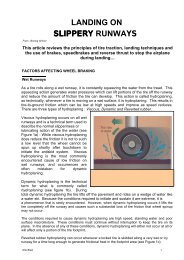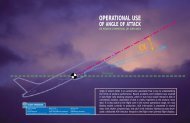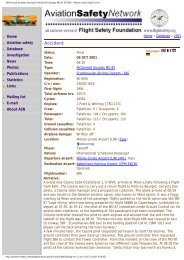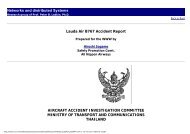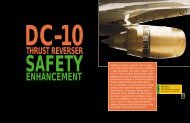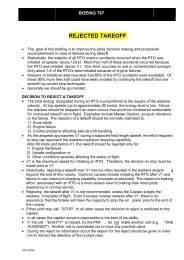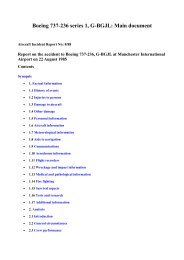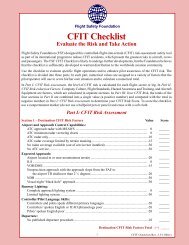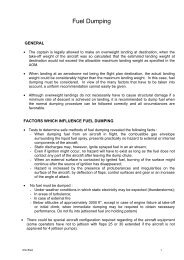ASN Aircraft accident description Boeing 767-2J6ER B ... - Leonardo
ASN Aircraft accident description Boeing 767-2J6ER B ... - Leonardo
ASN Aircraft accident description Boeing 767-2J6ER B ... - Leonardo
- No tags were found...
Create successful ePaper yourself
Turn your PDF publications into a flip-book with our unique Google optimized e-Paper software.
<strong>ASN</strong> <strong>Aircraft</strong> <strong>accident</strong> <strong>description</strong> <strong>Boeing</strong> <strong>767</strong>-<strong>2J6ER</strong> B-2552 - Pusan-Kimhae Airport (PUS)runway the autopilot was reengaged with heading select. At that moment the approachcontroller again contacted flight 129 instructing them to contactthe tower. The crew were busy looking outside to see when they passed abeam the endof the runway. Simultaneously the Gimhae Tower controller contactedthe flight using the emergency frequency. As they passed abeam the threshold at11:20:02 they started timing to measure the commencement f turning tobase. Eleven seconds after the call on the emergency frequency, the second officerreported to the Tower controller that they were on the circle approach. At 11:20:17 thecaptain took over control from the first officer and said he was going to turn base. Heslowly began a widening turn, causing the first officer to urge him: "turn quickly, not toolate." Meanwhile the flight was cleared to land . At 11:20:32 the captain disconnectedthe autopilot and banked the plane to the right. Twenty-two seconds later the firstofficer cautioned: "Pay attention to the altitude keeping," and the captain asked him tohelp him get a visual on the runway. Due to the limited visibility they were not able tosee the runway. The first officer then advised the captain to initiate a go around, butthe captain didnot respond. At 11:21:15 the first officer said, "Pull up! Pull up!" Pitch attitude wasincreased to 11.4 degrees but thrust was not increased. Two seconds later the aircraftimpacted a mountain, about 4.6 km from the runway.FINDINGS RELATED TO PROBABLE CAUSES:1. The flight crew of flight 129 performed the circling approach, not being aware of theweather minima of wide-body aircraft (B<strong>767</strong>-200) for landing, and in the approachbriefing, did not include the missed approach, etc., among the items specified in AirChina's operations and training manuals.2. The flight crew exercised poor crew resource management and lost situationalawareness during the circling approach to runway 18R, which led them to fly outside ofthe circling approach area, delaying the base turn, contrary to the captain's intention tomake a timely base turn.3. The flight crew did not execute a missed approach when they lost sight of the runwayduring the circling approach to runway 18R, which led them to strike high terrain(mountain) near the airport.4. When the first officer advised the captain to execute a missed approach about 5seconds before impact, the captain did not react, nor did the first officer initiate themissed approach himself.Events:Result - CFIT - Hill, mountainSources:» <strong>Aircraft</strong> Accident Report KAIB/AAR F0201Statistics10 th loss of a <strong>Boeing</strong> <strong>767</strong>5 th worst <strong>accident</strong> involving a <strong>Boeing</strong> <strong>767</strong> (at the time)5 th worst <strong>accident</strong> involving a <strong>Boeing</strong> <strong>767</strong> (currently)The worst <strong>accident</strong> in South Korea (at the time)The worst <strong>accident</strong> in South Korea (currently)» figures explainedPhotoshttp://aviation-safety.net/database/record.php?id=20020415-0&lang=en (2 van 3) [27-3-2007 10:14:37]



